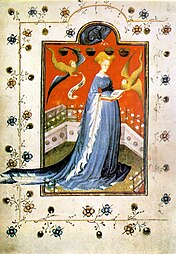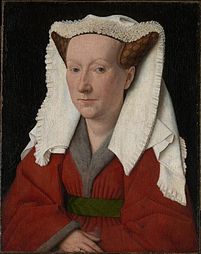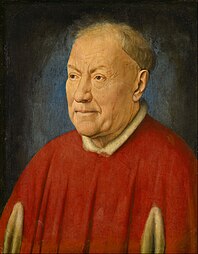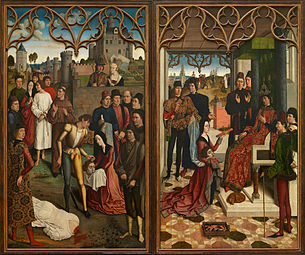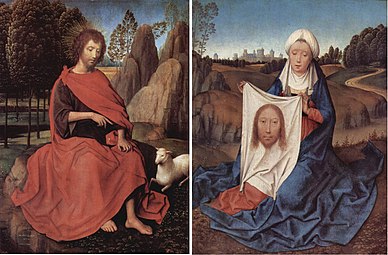ENA notes
|
|---|
Religious paintings 1500-50 edit
Bruegel edit
Italy edit
15th century art market & patronage edit
Pacht edit
Diptychs edit
Illustrated mss edit
Tapestries edit
Rediscovery and scholarship edit
Iluminated manuscripts gallery edit
Portrait gallery edit
Diptych gallery edit
|
Beaune Altarpiece edit
tfa notes edit
|
Nativity (Christus) editUpton edit
Ainsworth edit
Gellman edit
Misc edit
Review by: Jos Koldeweij Simiolus: Netherlands Quarterly for the History of Art, Vol. 23, No. 4 (1995), pp. 268-273 Published by: Stichting voor Nederlandse Kunsthistorische Publicaties Stable URL: http://www.jstor.org/stable/3780799 .
|
Madonna of the Dry Tree
Links edit
ainsworth (1994) edit
- Confraternity
Confraternity met in the Church of the Friars Minor - destroyed in 1620 (see note 6) 164Oddly only one Madonna of the Dry Tree is associated w/ the confraternity, Pieter Claeissens the Elder's triptych of c. 1520 (see note 7).164Christus's painting not listed in 1495 church inventory.164Perhaps commissioned for a member of the confraternity instead of for the chapel. Small size suggests individual devotional piece. 164Bound archives are stamped w/ an emblem of the Virgin standing in a thorny tree w/ dangling As; which suggests an official nature of the iconography, but basically not known who commissioned it. 164
- Description
- similar to Madonna of Nicolas van Maelbeke and Madonna of Jan Vos, (christ child motif); Madonna in the Church and Madonna at the Fountain robe drapery; and van der Weyden's motif of child wearing shirt. 164
- Christus employed illuminated manuscript painting techniques: he placed "tiny daubs of pure color to achieve three-dimensional effects", Virgin's left hand, child's toes, dangling As. (we need a higher res image). 164 style/technique/description?
- Virgin's robe = blending of red/blue/gree; Child's shirt "achieved by juxtaposing strokes of pure white and gray that merge when viewed from a distance". 164 style/technique/description?
- Ainsworth re the painting: "Small in size but not in impact, this painting exemplifies the peak of Christus's ability". 164
- Attribution and dating
- Since Grete Ring's 1919 attribution, no debate as to authorship. However there has been debate regarding the dating. 164
- Proponents of a date of c. 1444 point to resemblance to Exeter Madonna & JvE's Madonna of Jan Vos (she says Frick's Virgin and child) 164
- Christus's membership in the Confraternity of the Dry tree in the 1460s, & similarities to Madonna in the Church combined with Christus's renewed interest in conflating JvE w/ RvdW late in career (possible Memling introduced Christus to RvdW) as seen in Nativity (Memling) suggest date of early to mid-1460s 164
Upton edit
- description
- Dry Tree = peak Christus's ability to draw the viewer into and image, to experience it "as a subjective extension of our lives" 60
- "In place of the visual splendor or the royal display, this panel embodies a more muted quietude of private thought and silent reverence" 60
- Similar to Portrait of a Young Girl (Christus), for "stark abruptness of its design and color", but this was his best 60
- Pure black, red & gold, = "summon us [the viewer] with an emblem like simplicity to investigate more closely the subtle complexities of a most elaborate devotional image" 60
- Mary = serene & demure, stands in fork of the tree, 15 gothic letter As hang randomly create "shimmering pattern of reflected light" 60
- Tree grows against darkened void, warmth of the madonna suggests life, growth etc 60
- Christ child in his mother's arms, his foot clasped playfully. He is draped in linen & holds a crystal globe surmounted w/ cross = symbol of sovereignty 60
- Unlike JvE's Madonna in the Church, perhaps its model (Upton says counterpart), Christus's Mary is dressed in plainly, unadorned blue dress (some ermine at cuffs), red mantle lined with green. Hair is parted in the middle & held back by a simple thin black diadem (inset w/ pearls?? (can't see that)). 60
- Very small painting (14.7x12.4 cm) >> almost certainly a devotional piece, either commissioned by a member of the confraternity or belonging to Christus himself > handheld like Rosary beads for private devotion 65
- Christus's miniature devotional images were meant to allow viewers to meditate fully on the subject, to be absolutely absorbed as though they were actually seeing Mary and child. 65
- technique/style (or whatever we call this section)
- Tree is gray/gree w/ yellow tips. Lifeless tree juxtaposed against sparkling color 60
- The Virgin's bright red mantle is emphasized by the color contrast of its yellow-green lining 64
- Tree rises from center of lower border "repeatedly used by Christus to join physically, actual and pictorial realities" 65
- Hanging As reflect light 65
- Prickly tree branches scratch to edges lending a tactile sensation 65
- Christus's miniature devotional images were meant to allow viewers to meditate fully on the subject, to be absolutely absorbed as though they were actually seeing Mary and child. 65
- tree motif/iconography
- Tree motif refers to Tree of Knowledge, died/withered at fall & revitalized at birth of christ 60
- Crown of thorns = Christs passion > tree that caused mankind to be cast out becomes instrument of his return to grace 60
- seth's legend 60
- Tree graft motif - Guillaume de Deguileville in his Le Pèlerinage de l'Âme (The Pilgrimage of the Soul) >> "man's second chance was brought about by Christ's sinless birth", the Virgin's immaculate conception, and Mary conceived by St. Anne who had been barren, "just as a flourishing branch from the Tree of Life was grafted on to the dried Tree of Knowledge" 61
- Painting almost certainly commissioned by someone who was a member of the confraternity, along w/ the most powerful men of Philip's court, would have known about his vision & also the direct allusion to Ezekiel 12:24 "And all the trees of the country shall know that I the Lord have brought down the high tree, and exalted the low tree: and have dried up the green tree, and have caused the dry tree to flourish" 62
- Tree motif/iconography reflects the legends about Philip and Ezekiel, but Christus composition is unique. 62
- The composition is probably related to the confraternity and based on the medallions of the Madonna of the Dry Tree, none of which survive. 63
- Upton doubts Pieter Claeissens the Younger's triptych commissioned for the confraternity is based on a prototype of Christus's version, as Grete Ring thought, because of the stark differences in iconography (maybe come back to this), re Old Testament vs. New Testament. 63
- Madonna & child w/ tree seen in Christus's Nativity - seems to be an iconography Christus likes 64
- Upton believes, to be the origin of Christus's iconography. He thinks the painting is uniquely "Christus's own invention" 64
- 15 "A"s correspond to Ave Maria, to the prayers of the Rosary & to Marys five joyful, five glorious & five Sorrowful mysteries Rosary#Mysteries of the Rosary 64
van der Velden edit
- "figures are strongly lit" 89
- Pieter Claeissens the Younger's 1620 triptych Our Lady of the Dry Tree (1620) "provides the key" to identifying Christus's painting. Claeyssens' altarpiece has side panels w/ Moses & burning bush, and Gideon and the Golden Fleece. Claeyssens commission contract indicates the biblical narratives on the two panels were meant to represent Mary's "immaculate virginal purity" or Virgin Birth. 89
- The "Fleece and Burning bush were well known prefigurations" of Virgin birth, but van der Velden says that Claeyssens' iconography is not a direct reference to Immaculate conception which by then was the "object of the confraternity's devotion". 90
- Van der Velden explains that it was widely believed the core of the belief of the confraternity was the Immaculate conception, but that in reality "the confraternity of Our Lady of the Dry Tree was not established in support of the doctrine, nor was it devoted to its propagation". 91
- Christus's painting based on Ezekiel - & Deguileville's 1330 allegory = "metaphorically as an act of God, who grafted a branch from the Tree of Life onto a barren trunk". Also St Anne?? 92
- Ainsworth says a direct translation of Deguileville's allegory - van der Velden not sure 92
- Panofsky says directly from Ezekiel and the tree made to live w/ a graft 93-4
- Might mean "far reaching heroic legend of regeneration" (Upton) or even Philip's idea for a new Jerusalem or crusade 94
- Van der Velden rejects all these theories and argues (in the next 16 pages) the confraternity was based on an image of Mary "suspended in a dry - meaning a dead- tree when it first manifested its miraculous potency". The miracle tree was the reason for establishing the confraternity he says, and after 1396 the img of Mary removed from the image and moved into the the chapel. He thinks the painting is a reproduction of a (statue??) 94
- The "forked tree is the distinguishing characteristic of the image" 94
- Marian confraternities generally venerated a specific Marian image; the confraternities in Bruges less studied than those in Ghent, but the Dry Tree seems to be typical. 96
- Archival records confirm the confraternity had a statue on the altar. 97
- 1469 contract w/ Franciscan's renegotiated (Christus was a signatory) w/ list of 'gifts'. Only God gave miracles but "they manifested themselves through particular agents, usually a shrine or a cult image". 97
- Expiatory rites performed in front the image of Our Lady of the Dry tree 97
- Our Lady of the Oak in Meerveldhoven venerated from 13th cent to present. Original oak cut down in 1648 - now there's a tree in the chapel 98
- Re Our Lady of the Dry Tree confraternity in Ghent & its traditions 99
- Van der Velden mentions that Christus' tree has been compared to the crown of thorns, but it's clearly a tree 99
- Often chapels were established in places where a tree held an image of Mary (a few pages about this w/ examples) 102
- Small trees served as altar ornaments; Bruges Dry Tree confrat. mentions two small silver trees in its inventory - one used as an Aspergillum 104
- Our Lady on the Stock >> come back to this. (Try to find the image). Original tree became attributes "denoting the all-important link between a specific image and its particular provenance, lots of examples. 106
- Van der Velden believes Christus's painting is faithful depiction of the tree and an accurate reproduction of the placement of the Virgin's image. 108
- He believes that painting was commissioned as a devotional image & meant to accurately convey the cult image of the Lady of the Dry Tree 109
- He believes the confraternity venerated a cult image, as was common, and that the "iconography is an explicit and unequivocal testimony to her cult" 109
Pagagnotti Triptych edit
- Ainsworth, Maryan Ainsworth. "The Business of Art
- Patrons, Clients and Art Markets". Maryann Ainsworth, et. al.(eds.) From van Eyck to Bruegel: Early Netherlandish Painting in the Metropolitan Museum of Art. (1998). Metropolitan Museum, New York. ISBN 0-87099-871-4 (23-38)
- Memling received many commissions from the Italian community in Bruges, particularly for portraits such as his Portrait of Tommaso Portinari and his wife Maria. To appeal to his foreign clients Memling introduced Italianate motifs to his Northern style, blending the two, adding elements such as elaborate and fancy swagging hanging from the canopies of honor and the introduction of cherubs (putti) in some of his depictions or the Virgin and Child enthroned. (Ainsworth, 1998, 34-35)
- Christiansen, Keith. "The View from Italy". Maryan Ainsworth, et. al. (eds.) From van Eyck to Bruegel: Early Netherlandish Painting in the Metropolitan Museum of Art. (1998). Metropolitan Museum, New York. ISBN 0-87099-871-4 (23-38)
- Art from Burgundian Netherlands in vogue and sought after in Italian courts 40
- Duke of Milan sent a painter to study with van der Weyden to learn portraiture and set a precedent other dukes followed. 41
- Strong commercial ties between Bruges and Italy >> Medici bankers etc. 43
- Genoese traders in Bruges gained appreciation for northern artists & art & brought it (appreciation and art) south with them 44
- Large percentage of Netherlandish painting sold to Italy went to the Medici - often via middlemen Tani & Portinari at the Bruges branch of Medici bank - but not all, i.e Portinari van der Goes’ (‘’Portinari Altarpiece’’) & Pagagnotti. 44
- Memling had a v strong Italian client base [mentioned above too] 45
- Because Italian nobility/princes collected Netherlandish paintings, Italian painters began to emulate landscapes, imagery, iconography and techniques. 49
- Filippino Lippi copied Hugo van der Goes' Portinari Altarpiece, brought to Florence in 1483 49
- The landscapes tend to be jarring in the Italian painting, perhaps added on the whim of the patron 53
- Memling had a significant and often overlooked influence on Italian painting - in part because so many of his patrons were Italian, he melded northern style with what his Italian patron demanded of him, particularly in his portraits. 55
- His devotional paintings too (i.e, Virgin and Child with two angels ) melded well and perhaps paved the way for a more serene "harmonious" "tranquil" style the Italian painters sought 57
- Memling quoted extensively by Florentine artists, i.e Fra Bartolomeo’s Madonna and Child with a young St John the Baptist = direct quote from Pagagnotti triptych 56-57 File:Fra bartolomeo, madonna col bambino e san giovannino, 1497.JPG File:Fra bartolomeo, madonna col bambino e san giovannino.jpg
- Ainsworth
- “Saint Paul with Paulo Pagagnotti; Christ appearing to his Mother” by the Master of the Legend of St. Ursula (also divided/separated and newly identified) was commissioned by merchant Paulo Pagagnotti, perhaps in Bruges, Ainsworth says late 1480s. It’s possible he ordered his uncle’s painting at the same time. Ainsworth dates triptych after 1484. Uncle = “learned Domincan Benedetto Pagagnotti” elected Bishop of Vaison. 122
- Or a Medici agent may have ordered it 122
- Benedetto Pagagnotti moved to Maria Nuova; painting there until wings?? transferred to Uffizi in 1852 122-124
- Interior = “extraordinarily beautiful and refined interior panels” 174
- Benedetto Pagagnotti seems to have chosen the cranes as play on the Greek word for bishop. 174
- Ainsworth believes the exteriors share “emblematic character” of “Young woman with a pink” and “Two Horses and a monkey in a landscape” - very weak execution, probably by workshop members. 174
- Ainsworth speculates that the generic landscape in the wings, similar to Young Woman with a Pink, was by a member of the workshop. 175
- Nuttall
- Small devotional triptych - Nuttall 25
- Considered one the earliest Netherlandish painting to employ putti and garlands associated with Italian sculpture (see list of other painting but can’t identify them)- Nuttall, 25
- Painted for Dominican Benedetto Pagagnotti, leading churchman in Florence. 25
- Dating c. 1480 based on mill in background, copied by Italian painters, the first by Filipino Lippi c 1482. 25
- Netherlandish devotional paintings much in vogue in Italy; Pagagnotti probably placed commission through a middleman, perhaps relative Paulo Pagagnotti who is documented visiting Bruges 25
- Memling added Italian flourishes of garlands and putti either at behest of patron to please him; additional Italianate motifs include include arch carvings > Cain slaying Abel, Samson & the lion painted to resemble gilded sculptures and decorative detail of the arch 25
- Pair of tondo in Portinari’s Bruges home Bladelinhof include lions head and putti >> prob commissioned c. 1469 >> Memling would have been familiar 25 (see pics of Bladelinhof) plus much more about this
- Virgin and Child sit enthroned under ornate rounded arch - outer rim has all’antica motif of half-rosettes 29. See Nat gallery for all’antica definition
- Wings have gothic arches bordered w/ palmettes 29
- Corner columns supporting Cain/Abel & Samson on capitals exhibit all’antica motifs 29
- Red marble columns (center & wings) are Netherlandish motif found from van Eyck onward; ornate gold capitals and bases seem to be Memling’s innovation, 29
- Center panel columns have Gothic vegetal motif 30
- Wings combine delicate late Gothic arches framing columns w/ Corinthian acanthus (ornament) leaf motif, blending architectural details from north and south of the Alps 30
- Center panel arch’s inner rim is decorated w/ a vine (symbolizes eucharist) on the left and ivy (symbolizes immortality) on the right painted to simulate metal or gilded wood, Nuttall writes, “these are concomitantly a tour de force of naturalistic observation, with their curling tendrils and delicate roots, as are the two pairs of snail and a lizard beneath them”, 30
- Garland bearing putti perched atop the columns widespread by Memling’s time 30 (come back to this) 31
- Rohlmann
- Nat Gall acquired the wings in 19th cent 438 depict on one side saints “within an architectural frame” 438
- Italians plagiarized landscapes from wings too, I.e Biagio d'Antonio 438
- Wings depict saints “within an architectural frame”; the other side depicts “fascinating scenes of nine cranes in a dark twilight landscape, at the horizon of which glows a pale pink sky. From out of the landscape loom the shadowy grey forms of the resting birds, their red crests shining out as isolated points of colour”. 438
- Uffizi Virgin with Child and the Nat Gallery wings have the same dimensions; the triptych identification is based on dimensions, steps & floor tiles, & similar architectural features 439
- Landscape of Uffizi Virgin & Child also frequently plagiarized 439
- Fra Bartolomeo’s Virgin and Child, col Bambino e san Giovannino (Fra Bartolomeo New York) (Italian) combines background from center panel and left side panel, clinches identification 439
- Garlands above held in place by putti ‘’all’antica’’ > renaissance motif accompanied w/ late Gothic tracery on wings [reword] 439
- Wing reverse has birds instead of usual grisaille saints; coat of arms adorned w/ pairs of compasses hangs above the cranes. 439
- Same coat of arms appear on the Master of the Legend of St Ursula Madonna >> also originally a triptych & now inner at Met & outer at Museo Bandini, Fiesole 439 (find this)
- Heraldry belongs to Florentine Pagagnotti family 439
- John the Baptist holding the Lamb of God is patron saint of Florence; Lawrence prob = Lorenzo Medici > gazes directly at the beholder/patron/buyer; Mary presents the child of god flanked by angels 444
- Triptych may have been acquired directly by the Bruges branch for Pagagnotti [cp], or possibly Paulo commissioned when visiting & commissioned similar from Master of St Ursula 444
- Sources
- Ainsworth, Maryan. ‘’From Van Eyck to Bruegels, Early Netherlandish Painting … p. 174 (on bookshelf)
- Brown, Beverly Louise. “Florence and the Netherlands. Florence and Paris.” The Burlington Magazine, vol. 150, no. 1266, 2008, pp. 639–641. JSTOR, www.jstor.org/stable/40479890. Accessed 16 July 2021.
- Nuttall, Paula. "Memling’s Pagagnotti 'Virgin and Child': Italian Renaissance Sculpture Reimagined. Sculptures Journal, vol 26. Issue 1, 2017, pp 25–36
- Rohlmann, Michael. “Memling's 'Pagagnotti Triptych'.” The Burlington Magazine, vol. 137, no. 1108, 1995, pp. 438–445. JSTOR, www.jstor.org/stable/886499. Accessed 16 July 2021.

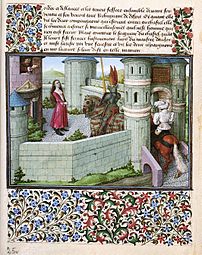
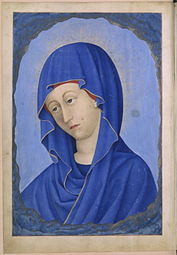



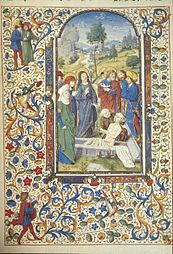
![Hastings Book of Hours, Master of the First Prayer Book of Maximilian I, Bruges or Ghent c. 1470, [1]](http://upload.wikimedia.org/wikipedia/commons/thumb/d/d1/Hastings_book_of_the_hours.jpg/185px-Hastings_book_of_the_hours.jpg)

